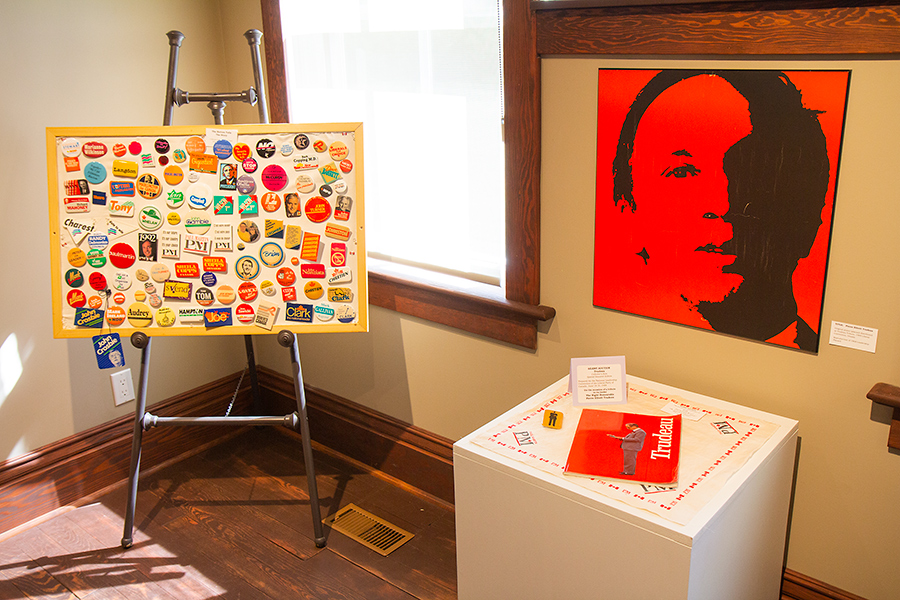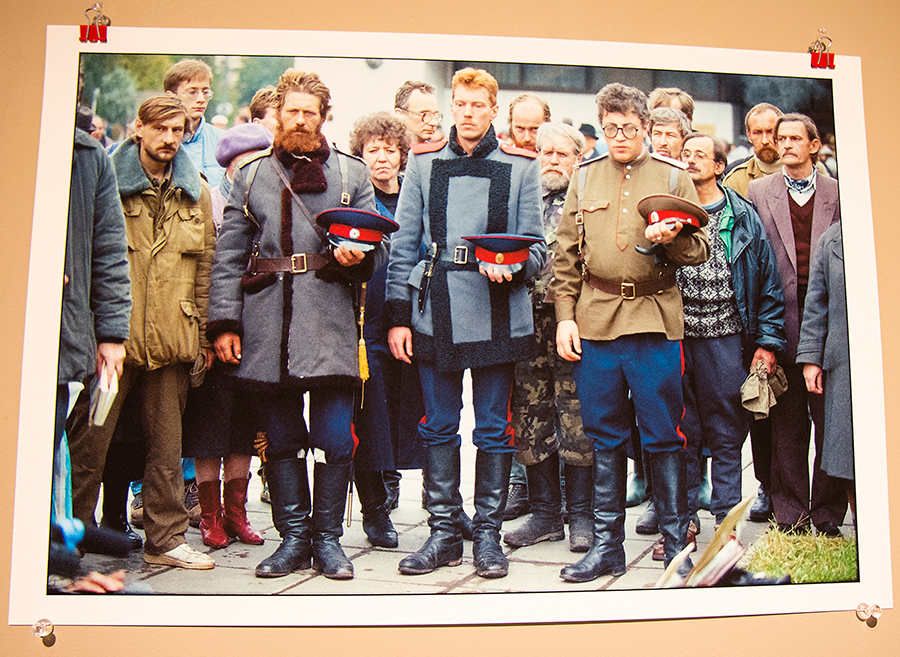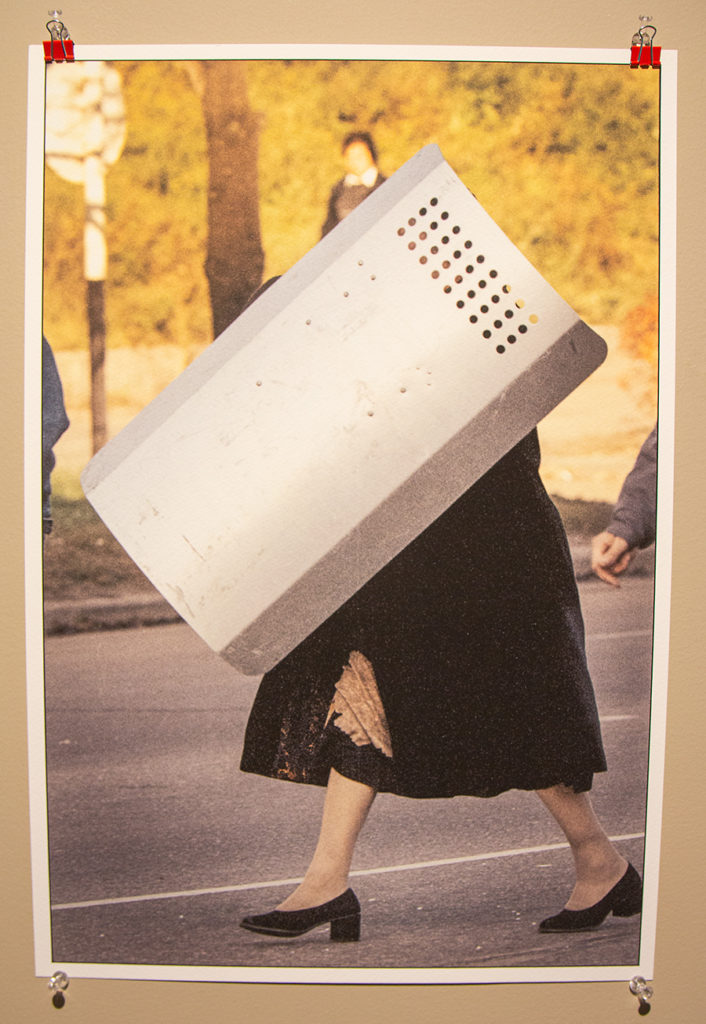
Gallery exhibition closes this Saturday at the Heritage Home for the Arts
BY KIM LANGEN
It took over a year to organize, and arts administrator Jane Ireland is thrilled with the sharp calibre of political art on display this month at the local gallery.
“Why shouldn’t a small town have an exhibition like this?” said Ireland. “I came up with the idea last year, and it came together thanks to so many wonderful people, and at such a tumultuous time. Who could have predicted a year ago that we would be living through a pandemic, government scandals, international protests and counter-protests, and civil disobedience against racism? You might almost think that our September exhibition was predestined.”
The exhibition features the work of a number of politically charged artists such as Killarney-raised international photojournalist Phil Hossack (covering the 1993 attempted Russian coup in Moscow), and the work of the late international artist Dennis Tourbin (the FLQ terrorism and October Crisis of 1970).
Spanish-born painter Maria Lezon is featured with her three colourful images of the Queen of England (relaxed in the real world), while Bhat Boy presents one of his works in the tradition of medieval paintings, and incorporating selective scale and whimsy. There is also work by the late American lithographer Rich Ahern, featuring his panoramic print of Parliament Hill.
And the work of renowned writer and cartoonist Terry Mosher, who used the name of his eldest daughter, Aislin, as his nom de plume, can be seen in the Montreal Gazette’s striking cartoon of a laughing Queen, published in August, 1973, with Prince Philip balanced on her knee, depicted as a puppet.
Below this cartoon is a letter of complaint, sent within hours from Buckingham Palace’s Press Secretary to the Queen to the newspaper’s editor, demanding that the Gazette explain the meaning of the cartoon.
This is an exhibition not to be missed. It is a journey into the past for many of us, who may still remember the days of the horrifying FLQ crisis, and the shocking statement from Pierre Trudeau during those hours that martial law was to be imposed for the first time during peacetime in Canada.
And the vivid and emotional images of Hossack’s Russian people taking to the streets – many of them rendered homeless and destitute following the change from one of communist provision to one of democratic corruption – is an eye-opening experience, seen up close and personal through Hossack’s camera lens in the centre of Moscow.
“Art can be breath-taking, emotional, and spiritual, created to share a special aesthetic,” said Ireland. “But art can (also) challenge us to see more by exposing oppression, injustice, and evil, while offering up visions of resistance and hope. It speaks across borders, across cultures, across political stripes. For many artists, the personal is truly the political.”
The Art of the Political gallery exhibition runs until Saturday, September 26, at the Heritage Home for the Arts, 44 Water Avenue, Killarney, (across from Erin Park). The gallery is open Tuesday to Saturday, from noon to 4 p.m.

THE QUEEN AT PLAY – Painter Maria Lezon, raised in Spain during the tail end of the Franco dictatorship, has contributed three pieces of artwork to the current Art of the Political exhibition at the Heritage Home for the Arts – all featuring the image of Queen Elizabeth II. “My paintings are colourful and exaggerated images, where most likely a woman is going about her regular day, somewhere in contemporary Western culture,” says Lezon. “These three pictures are part of a larger work from the 1990s, when I was a young artist moving from Saskatchewan to Ontario, where I experienced a cultural shock. My work is political, and I mix humour and middle class aesthetics to deliver political and social ideas.”

TAKE YOUR PICK FROM A LIFETIME OF BUTTONS, OR TRUDEAU – David Pepper, the brother of gallery administrator Jane Ireland, was so impressed with the new Heritage Home for the Arts that he offered up some of his wonderful and historical political gems for sale and auction to benefit the art gallery.
On the left, Pepper’s lifetime collection of buttons, which are available for around $5 each. Pins are just $2 each, and the Trudeau book (right), a silent auction item, has a reserve price of $75. There are also caricature books for auction, by renowned Canadian political cartoonist, Aislin. “You put your name down next to the items, and place your bid,” said Ireland. “The auction closes the last day of our ‘Art of the Political’ exhibition. We will contact the people who win.”
The stunning graphic of Pierre Trudeau (above), created for the Liberal Party Convention of 1984, and the year Trudeau retired, is not for sale.
Read on for more on Phil Hossack’s Moscow story.

International photojournalist Phil Hossack on display.
KIM LANGEN/KILLARNEY GUIDE PHOTOS
The Last Coup
By Phil Hossack
“Invited in through a gap in the tangle of steel, concrete, and rock, I came face to face with the protestors.” Phil Hossack, an award-winning photojournalist who witnessed and documented the 1993 conflict/coup in Russia between rebel forces and Boris Yeltsin’s troops
In 1993, at the invitation of a colleague who moved to Moscow, Russia, I travelled to the hub of the former Soviet Empire just after its collapse.
Traveling on an easier-to-obtain tourist visa, I was a well-equipped photojournalist looking to satisfy a childhood interest in Russian history and culture.
After landing in Moscow, and settling into a small, newly-privatized hotel on the main floor of a crumbling apartment tower, wary staff were startled at their first glimpse of the “American.”
My accommodations, arranged via a ‘friend of my friend,’ were an under-the-table arrangement for the cash equivalent of the rent he paid in an upstairs apartment to the buildings new ‘owner.’
I started to explore the city on foot and on the transit system. A street perspective truly provides an intimate perspective.
I soon found myself looking across the Moscow River towards the Russian Parliament Building, or the “White House.” My gaze met, across a rusty radiator, a former ‘Citizen’ bearing the old Communist flag above a barricade erected by protestors surrounding the White House.
Invited in through a gap in the tangle of steel, concrete, and rock, I came face to face with the protestors. Senior citizens, suddenly unable to afford rent in newly privatized apartments; workers who were unable to survive on wages unpaid for months. When wages were paid, the money earned couldn’t buy groceries in post-communist Russian communities.
They gathered to stand against faltering democratic changes, and soon, over the four weeks I spent with them, they were joined by more desperate and violent elements, hoping to topple the Yeltsin government and re-establish their familiar Communist framework.
Over four weeks, ordinary citizens gathered in force, reinforced by veterans of foreign wars, soldiers from the White House Barracks, radical Communist groups, members of the Russian Nazi Party, and finally others with more fiery and deadly methods.
Eventually, while repelling riot police and attempting to take over the Russian telecommunication network, they were surrounded by elite Russian Paratroopers and tanks, and forced to surrender on the lawns of a burning Parliament building, which had been attacked by paratroopers dropping out of helicopters onto the roof, and shelled by Russian Army tanks from across the Moscow River.
It was a terrifying, fascinating month of enlightenment on Russian history.
Hanging these photos 27 years later in my home town, I see the repetition and struggle in the eyes of those who erected the barricades, who came to the streets to express their outrage and desperation, unable to survive the corrupt wake swirling behind their government.
These people took me into their lives, allowing me to make a portrait, to document their lives as they were, for what they were. Raising a fist in Communist solidarity, praying, singing, fighting, and, in too many cases, dying.
I look for the common thread in stories I get to share, and we have a lot in common, these ‘citizens’ and us.
I look at a series of three images, men running through a crossfire to shelter behind an open wall, laughing.
Today in the news, ordinary citizens still take to the streets. The parallels are there – capitalist corruption, long lines of police with shields, soldiers fighting their own citizens, bigotry, patriarchy – all bringing populations to the street in outrage, too often making their point violently; death making too many martyrs.
It’s all there in the eyes, if you look closely.
Phil Hossack’s Russian photos are currently on display at the Heritage Home for the Arts, part of The Art of the Political exhibition.

FOREFATHERS – In this photo by Phil Hossack, three young men have donned the Soviet uniforms of their forefathers. Hossack captured the sober image in Moscow back in 1993, during an attempted coup there by rebel forces, who tried to return Russia to its former communist rule.

BABUSHKA WITH REBELLlON ON HER MIND – This arresting image captured by Phil Hossack in 1993 won him the World Press Organization’s Award of Excellence. The lady in the photo carried a riot shield, dropped by fleeing police, as she faced Red Army tanks on her way to rebel forces holed up inside the Russian Parliament buildings.

